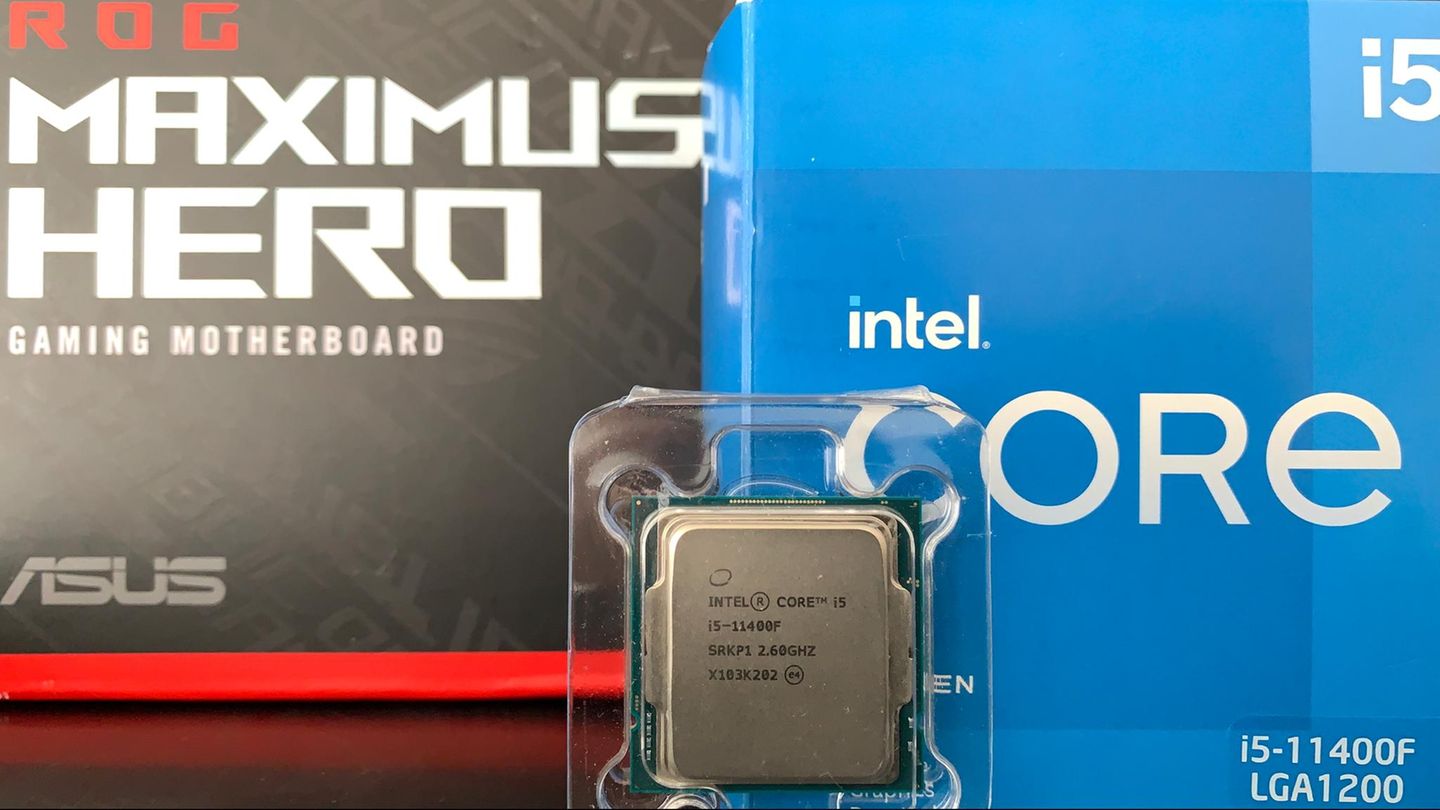With the Intel Core i5 11400F, Team Blau is causing a sensation in the budget segment. The test reveals who the processor is worthwhile for.
The Intel processors of the Rocket-Lake-S-Serie mark the last of their kind. Not only the 1200 socket of the chips ends, but also the manufacturing process in which the processors are manufactured: In the future, Intel will manufacture in 10 instead of 14 nanometers. Team Blau fans don’t have to wait long to get the first processors of the so-called Alder Lake Series are allowed to hold in their hands. The processors manufactured in the new process should already be in fourth quarter of 2021 come on the market.
This begs the question of what Intel actually wants with its Rocket Lake S series. Especially in the high-end segment, the manufacturer is unlikely to encourage prospective buyers with the Core i9 11900K – after all, the current top CPU from Intel has shrunk from ten to eight cores compared to its predecessor and has a higher power consumption . Far away from upper-class processors, Intel nevertheless caused a surprise with the . As usual for the F suffix at Intel, the processor does not have an integrated graphics unit and cannot be overclocked.
| Basic rate: | 2,6 Gigahertz |
| Turbo-Takt Singlecore: | 4,4 Gigahertz |
| Turbo-Takt Multicore: | 4,2 Gigahertz |
| TDP: | 65 Watt |
| Base: | LGA 1200 |
Core i5 11400F: Improvements over the predecessor
The direct predecessor of the Core i5 11400F was already a price-performance tip among gamers. Accordingly, Intel stayed true to its recommended retail price: for the Core i5 11400F, it is the same as at the market launch of the about 160 euros. However, the chip manufacturer improved the Rocket Lake S processor in important points:
- The Core i5 11400F supports PCIe 4.0 with up to 20 lanes – i.e. a PCIe 4.0 graphics card plus a PCIe 4.0 NVMe SSD
- After four years, Intel also changes its architecture: According to the manufacturer, “Cypress Cove” improves the “Instructios per Cycle”, ie how many instructions the processor can execute per clock cycle. Put simply, the Rocket Lake S processors deliver more performance than their predecessors at the same rate.
- Compared to the Core i5 10400F, the base clock of 2.6 gigahertz (GHz) is 200 megahertz (MHz) lower for the i5 11400F
- In contrast, the Turbo Boost for a core with 4.4 GHz is 100 MHz higher and the Turbo Boost for all cores with 4.2 GHz is 200 MHz higher than with the predecessor – the thermal power loss has remained the same at 65 watts – but more on that later more
- In addition, the working memory can be overclocked with the Core i5 11400F
Intel Core i5 11400F: The test system
- Mainboard: Asus ROG Maximus, 13 Hero
- RAM: 16 GB G.Skill Aegis DDR4-3200 CL-16-18-18-38 Dual Kit
- Cooler: Noctua NH-U12A
- Graphic card: Radeon Vega 56
- Power adapter: Kolink Enclave 80 Plus Gold, 600 Watt
With the exception of the mainboard, all components are more of the price-performance hardware category. The Core i5 11400F had to endure Cinebench R20 and R23 as well as Geekbench and the gaming benchmark of “Total War: Warhammer II” in terms of benchmarks. In the Total War benchmark, the resolution was reduced to 720p and the default setting was set to high in order to prevent the FPS limitation of the weak graphics card. That wasn’t necessary in the synthetic benchmarks. The main memory worked in dual-channel mode at 3200 megahertz.
In addition, the processor chased through the worlds of “Dota 2” and “Counter Strike: Global Offensive” in the esports test on a 144 Hertz monitor. As a reference, the ran a second six-core through the same tests on the same test system. Both processors ran at the preset standard clock, especially since Intel processors without a K suffix cannot be overclocked beyond the preset multiplier. However, the Core i5 11400F ran without power limitation. The power limitation regulates the maximum amount of current the processor can use.
In theory, the Core i5 11400F works with an average power consumption of 65 watts. When there is little to do, the processor needs less power, and accordingly more under full load. This is why the Intel processor inherently has two power levels that are supposed to compensate for the different workload. Means that if the processor has nothing to do for a long time, it gets more power for heavy tasks and thus clocks faster. However, this more power is limited to a maximum of 154 watts for 28 seconds (with the predecessor it was 134 watts for 28 seconds).
When the buffer is used up, the CPU clocks down again and consumes less power. Why it does this is clear: the average value of 65 watts must not be exceeded. This power limitation can be turned off on most motherboards, which most players do. Ready-made computers from Dell, HP and Co. usually adhere to the limitations of Intel – which is why gamers may want to refrain from such computers with the Core i5 11400F.
The test results:
| i5 11400F ohne PL | i5 11600K | Difference in performance | RRP difference | |
| Cinebench R20 Multicore | 3713 | 4313 | 14 percent | about 35 percent |
| Cinebench R23 Singlecore | 1375 | 1564 | 12 percent | |
| Cinebench R23 Multicore | 9629 | 11172 | 14 percent | |
| Geekbench Singlecore | 1566 | 1711 | 9.5 percent | |
| Geekbench Multicore | 7820 | 8289 | 6.7 percent | |
| “Total War: Warhammer 2” | avg. FPS 111,5 | avg. FPS 120,7 | 7.5 percent |
Both processors had no problems in the esports test. There were no noticeable frame drops in “Counter Strike: Global Offensive”. The game was played in Full HD with a low level of detail. The Intel Core i5 11400F scratched the top at 400 frames per second and didn’t even fall near 144 frames per second – perfect for 144 Hertz monitors.
The processor performed similarly well in “Dota 2”. Played again in Full HD with a low level of detail. In heated team fights, the images per second sometimes dropped to around 120 per second, at the top he calculated around 220 images.
The pure performance data of the benchmarks results in an average of 12.74 percent less performance, which the Intel Core i5 11400F brings compared to its big brother. Compared with a price difference between the recommended retail price of both processors of around 35 percent, most gamers are better advised to use the Intel Core i5 11400F. “All theory is gray in life, it is decisive in the place”, the great Alfred Preissler already knew to say. And the current price counts on the pitch.
Because the Core i5 11400F is so popular, its price has even risen. The processor is currently around 200 euros. In comparison, the Core i5 11600K costs just 229 euros on Amazon (July 21, 2021) – that’s a price difference of around 13 percent. And that pretty much coincides with the increased performance of a Core i5 11600K.
Core i5 11400F: Ryzen logged off
And what is the competition doing? The Ryzen 5 5600X costs around 280 euros in July 2021 and thus falls into the next higher price category. The Ryzen 5 3600X remains for currently around 210 euros – too expensive, because more performance is not possible with the chip compared to both Intel processors – on the contrary. In the segment around 200 euros, Intel has deregistered AMD – and is making itself the greatest competition. Because the predecessor of the Core i5 11400F currently costs around 160 euros. Those who can do without the higher RAM frequency, PCIe 4.0 and the higher performance provided by the Core i5 11400F will find the previous model also currently has a very good price-performance ratio.
Conclusion
If the Core i5 11400F for its recommended retail price, it offers the best value for money for budget gamers under 200 euros. However, they want to make sure that they have a mainboard with which they can switch off the power limit of the processor. In addition, buyers should plan money for a cooler. Before buying, interested parties should of course keep an eye on the current price.
Because on July 21, 2021 that would be Core i5 11600K the better alternative for the money. The processor is inherently clocked a bit higher than the Core i5 11400F. This is noticeable in the performance and should only attract very few buyers with the difference in the recommended retail price. Because the Core i5 11400F is currently offered well above its RRP, and the 11600K well below, the 11600K is a veritable alternative in the category of around 200 euros – provided a decent cooler is available.
David William is a talented author who has made a name for himself in the world of writing. He is a professional author who writes on a wide range of topics, from general interest to opinion news. David is currently working as a writer at 24 hours worlds where he brings his unique perspective and in-depth research to his articles, making them both informative and engaging.




